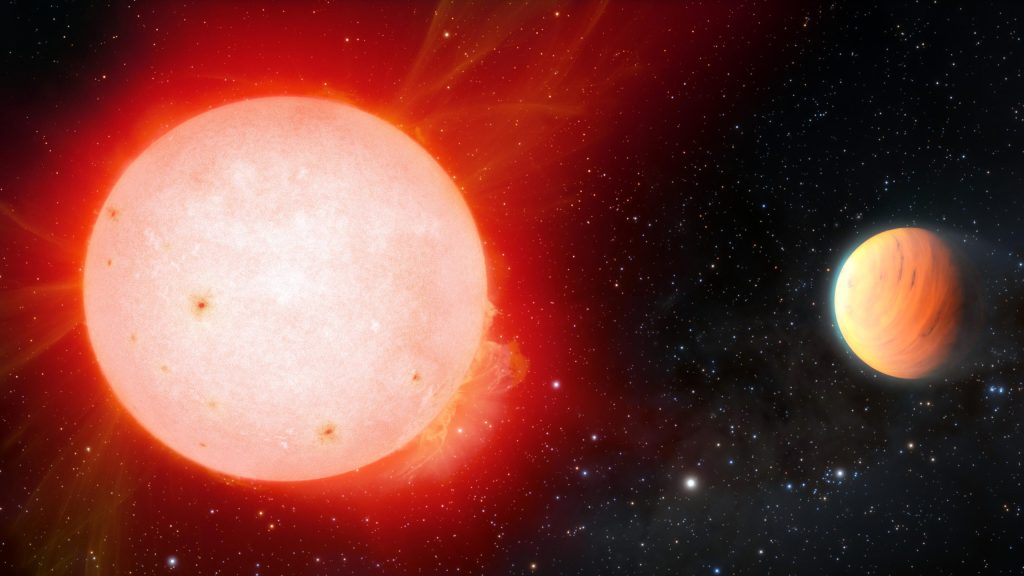
Impressão artística de um planeta gigante gasoso muito fino orbitando uma estrela anã vermelha. Planeta exterior gigante de gás [right] Densidade de marshmallows detectada em órbita em torno de uma estrela anã vermelha fria [left] pelo NEID Radial Velocity Instrument financiado pela NASA no Telescópio WIYN de 3,5 metros no Observatório Nacional Kitt Peak, um programa da NSF NOIRLab. O planeta, chamado TOI-3757 b, é o planeta gigante gasoso mais fino já descoberto em torno desse tipo de estrela. Crédito: NOIRLab/NSF/AURA/J. da Silva/Spaceengine/M. Zamani
O telescópio Kitt Peak do Observatório Nacional ajuda a determinar isso[{” attribute=””>Jupiter-like Planet is the lowest-density gas giant ever detected around a red dwarf.
A gas giant exoplanet with the density of a marshmallow has been detected in orbit around a cool red dwarf star. A suite of astronomical instruments was used to make the observations, including the NASA-funded NEID radial-velocity instrument on the WIYN 3.5-meter Telescope at Kitt Peak National Observatory, a Program of NSF’s NOIRLab. Named TOI-3757 b, the exoplanet is the fluffiest gas giant planet ever discovered around this type of star.
Using the WIYN 3.5-meter Telescope at Kitt Peak National Observatory in Arizona, astronomers have observed an unusual Jupiter-like planet in orbit around a cool red dwarf star. Located in the constellation of Auriga the Charioteer around 580 light-years from Earth, this planet, identified as TOI-3757 b, is the lowest-density planet ever detected around a red dwarf star and is estimated to have an average density akin to that of a marshmallow.
Red dwarf stars are the smallest and dimmest members of so-called main-sequence stars — stars that convert hydrogen into helium in their cores at a steady rate. Although they are “cool” compared to stars like our Sun, red dwarf stars can be extremely active and erupt with powerful flares. This can strip orbiting planets of their atmospheres, making this star system a seemingly inhospitable location to form such a gossamer planet.
Shubham Kanodia, pesquisador da Carnegie Institution for Science’s Earth and Planetary Laboratory e primeiro autor de um artigo publicado em Jornada Astrológicapara. Até agora, isso só foi visto por pequenas amostras de pesquisas Doppler, que geralmente encontraram planetas gigantes longe dessas estrelas anãs vermelhas. Até agora, não tivemos uma amostra grande o suficiente de planetas para encontrar planetas gasosos próximos de maneira robusta.”
Ainda existem mistérios inexplicáveis em torno do TOI-3757 b, o principal deles como um planeta gigante gasoso poderia se formar em torno de uma estrela anã vermelha, especialmente um planeta de baixa densidade. No entanto, a equipe de Kanodia acredita que pode ter uma solução para esse mistério.

Da Terra, do Observatório Nacional Kit Peak (KPNO), um programa da NSF NOIRLab, o telescópio Wisconsin-Indiana-Yale-Noirlab (WIYN) de 3,5 metros parece estar observando a Via Láctea à medida que se espalha no horizonte. O brilho atmosférico avermelhado, um fenômeno natural, também colore o horizonte. KPNO está localizado no deserto de Sonoran do Arizona na Nação Tohono O’odham e esta visão clara de parte do plano da Via Láctea mostra as condições favoráveis neste ambiente necessárias para ver corpos celestes fracos. Essas condições, que incluem baixos níveis de poluição luminosa, céus 20 graus mais escuros e condições climáticas secas, permitiram que os pesquisadores do consórcio WIYN continuassem a observar galáxias, nebulosas e exoplanetas, bem como muitos outros alvos astronômicos usando o WIYN 3.5 -metro e seu irmão, o telescópio WIYN de 0,9 metros. Crédito: KPNO/NOIRLab/NSF/AURA/R. Sparks
Eles sugerem que a densidade extremamente baixa do TOI-3757 b pode ser resultado de dois fatores. A primeira diz respeito ao núcleo rochoso do planeta; Acredita-se que os gigantes gasosos comecem como núcleos rochosos maciços com uma massa cerca de dez vezes a massa da Terra, ponto em que eles puxam rapidamente grandes quantidades de gás próximo para formar os gigantes gasosos que vemos hoje. TOI-3757b tem uma menor abundância de elementos pesados do que outras anãs M com gigantes gasosos, e isso pode ter resultado na formação do núcleo rochoso mais lentamente, retardando o início da acumulação de gás e afetando a densidade geral do planeta.
Um segundo fator pode ser a órbita do planeta, que parece ser ligeiramente elíptica. Há momentos em que se aproxima de sua estrela do que outras vezes, resultando em um aquecimento excessivo significativo que pode fazer com que a atmosfera do planeta inche.
Satélite de trânsito da NASA para pesquisa de exoplanetas ([{” attribute=””>TESS) initially spotted the planet. Kanodia’s team then made follow-up observations using ground-based instruments, including NEID and NESSI (NN-EXPLORE Exoplanet Stellar Speckle Imager), both housed at the WIYN 3.5-meter Telescope; the Habitable-zone Planet Finder (HPF) on the Hobby-Eberly Telescope; and the Red Buttes Observatory (RBO) in Wyoming.
TESS surveyed the crossing of this planet TOI-3757 b in front of its star, which allowed astronomers to calculate the planet’s diameter to be about 150,000 kilometers (100,000 miles) or about just slightly larger than that of Jupiter. The planet finishes one complete orbit around its host star in just 3.5 days, 25 times less than the closest planet in our Solar System — Mercury — which takes about 88 days to do so.
The astronomers then used NEID and HPF to measure the star’s apparent motion along the line of sight, also known as its radial velocity. These measurements provided the planet’s mass, which was calculated to be about one-quarter that of Jupiter, or about 85 times the mass of the Earth. Knowing the size and the mass allowed Kanodia’s team to calculate TOI-3757 b’s average density as being 0.27 grams per cubic centimeter (about 17 grams per cubic feet), which would make it less than half the density of Saturn (the lowest-density planet in the Solar System), about one quarter the density of water (meaning it would float if placed in a giant bathtub filled with water), or in fact, similar in density to a marshmallow.
“Potential future observations of the atmosphere of this planet using NASA’s new James Webb Space Telescope could help shed light on its puffy nature,” says Jessica Libby-Roberts, a postdoctoral researcher at Pennsylvania State University and the second author on this paper.
“Finding more such systems with giant planets — which were once theorized to be extremely rare around red dwarfs — is part of our goal to understand how planets form,” says Kanodia.
The discovery highlights the importance of NEID in its ability to confirm some of the candidate exoplanets currently being discovered by NASA’s TESS mission, providing important targets for the new James Webb Space Telescope (JWST) to follow up on and begin characterizing their atmospheres. This will in turn inform astronomers what the planets are made of and how they formed and, for potentially habitable rocky worlds, whether they might be able to support life.
Reference: “TOI-3757 b: A low-density gas giant orbiting a solar-metallicity M dwarf” by Shubham Kanodia, Jessica Libby-Roberts, Caleb I. Cañas, Joe P. Ninan, Suvrath Mahadevan, Gudmundur Stefansson, Andrea S. J. Lin, Sinclaire Jones, Andrew Monson, Brock A. Parker, Henry A. Kobulnicky, Tera N. Swaby, Luke Powers, Corey Beard, Chad F. Bender, Cullen H. Blake, William D. Cochran, Jiayin Dong, Scott A. Diddams, Connor Fredrick, Arvind F. Gupta, Samuel Halverson, Fred Hearty, Sarah E. Logsdon, Andrew J. Metcalf, Michael W. McElwain, Caroline Morley, Jayadev Rajagopal, Lawrence W. Ramsey, Paul Robertson, Arpita Roy, Christian Schwab, Ryan C. Terrien, John Wisniewski and Jason T. Wright, 5 August 2022, The Astronomical Journal.
DOI: 10.3847/1538-3881/ac7c20

“Maven da Web. Geek de cerveja irritantemente humilde. Fanático por bacon. Criador típico. Especialista em música.”





More Stories
Inspetor Geral da NASA emite relatório contundente sobre atrasos no projeto de lançamento da espaçonave SLS
Como os buracos negros ficaram tão grandes e rápidos? A resposta está no escuro
Uma estudante da Universidade da Carolina do Norte se tornará a mulher mais jovem a cruzar as fronteiras do espaço a bordo da Blue Origin